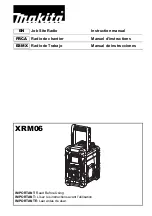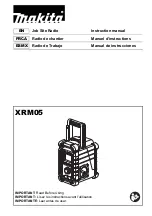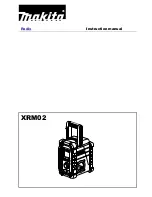
CM7/8 100Base-T System User’s Manual
Page xxv
Chapter 1–General Information
Figure 1-1.
CM7/8 100Base-T Digital Microwave Radio.................................................. 1-1
Figure 1-2.
CM 100Base-T Hot Standby System Block Diagram ..................................... 1-3
Figure 1-3.
Typical Single-Hop Configuration................................................................... 1-5
Figure 1-4.
Multi-Hop Configuration................................................................................. 1-5
Figure 1-5.
CM7/8 100Base-T Radio in Hot-Standby Configuration ................................ 1-7
Chapter 2–Principles of Operation
Figure 2-1.
RF Shelf; Hot-Standby TX/RX and Hot-Standby TX/Space Diversity RX .... 2-3
Figure 2-2.
Signal Processing Shelf in Protected Configuration........................................ 2-6
Figure 2-3.
Hot Standby TX, Hot Standby RX (HH) Signal Flow .................................... 2-7
Figure 2-4.
Hot Standby TX, Space Diversity RX (HS) Signal Flow................................ 2-8
Figure 2-5.
Non-Protected TX, Space Diversity RX (NS) ................................................. 2-9
Figure 2-6.
Non-Protected TX/RX (NN) Signal Flow ....................................................... 2-9
Figure 2-7.
Monitored Hot Standby Switching Diagram .................................................. 2-11
Figure 2-8.
Radio Loopback Levels ................................................................................. 2-14
Figure 2-9.
RF and IF Loopback Setup ............................................................................ 2-16
Chapter 3–Module Descriptions
Section 3-1–Radio Cabinet
Figure 3-1-1.
8209309-00 – 28DS1, 3DS3, 155-Mbps, and 100BaseT Access Panel ....... 3-1-2
Figure 3-1-2.
8209245-00 – 12DS1, 3DS3, 155-Mbps, and 100BaseT Access Panel ....... 3-1-3
Figure 3-1-3.
Power Distribution Diagram......................................................................... 3-1-4
Figure 3-1-4.
Features of the Universal 28DS1 to 100BaseT Access Panel (8209302-00) 3-1-5
Figure 3-1-5.
8209245-00 Access Panel Features .............................................................. 3-1-8
Figure 3-1-6.
SNMP Network Interface ............................................................................. 3-1-9
Figure 3-1-7.
SP Backplane Jumpers (from the front of the chassis) ............................... 3-1-11
Figure 3-1-8.
RF Shelf Backplane ( from the front of the rack) ....................................... 3-1-12
Section 3-2–RF Distribution
Figure 3-2-1.
HH (TX & RX Hot Standby) RF Distribution.............................................. 3-2-2
Figure 3-2-2.
HS (TX Hot Standby, RX Space Diversity) RF Distribution ....................... 3-2-2
Figure 3-2-3.
NS (TX Non-Protected, RX Space Diversity) RF Distribution.................... 3-2-3
Figure 3-2-4.
FF (TX & RX Frequency Diversity) RF Distribution .................................. 3-2-3
Figure 3-2-5.
NN (TX/RX Non-protected) RF Distribution............................................... 3-2-4
Figure 3-2-6.
Hot-Standby (HH) Waveguide FiltersFilters (HH)....................................... 3-2-4
Figure 3-2-7.
HS (Hot-Standby TX/Space Diversity Rx) Waveguide Filters..................... 3-2-5
Figure 3-2-8.
NS (Non-Protected TX/Space Diversity Rx) RF Distribution ..................... 3-2-5
Figure 3-2-9.
FF (TX/RX Frequency Diversity) RF Distribution ...................................... 3-2-6
Figure 3-2-10. NN (Non-Protected) RF Distribution ........................................................... 3-2-6
Section 3-3–Transmitter Unit (TXU)
Figure 3-3-1.
Transmitter Unit............................................................................................ 3-3-1
Figure 3-3-2.
TXU Block Diagram..................................................................................... 3-3-2
Figure 3-3-3.
Transmitter Features ..................................................................................... 3-3-3
Figure 3-3-4.
TXU Alarm/Control Board........................................................................... 3-3-4
List of Figures
Summary of Contents for CM7
Page 2: ......
Page 4: ...Page iv 5 04 05 CM7 8 100Base T System User s Manual ...
Page 16: ...Glossary Page xvi CM System Users Manual X Y Z ...
Page 24: ...Microwave Networks CM7 8 100Base T System User s Manual Pagexxiv ...
Page 62: ...Chapter 2 Operation Page 2 18 5 02 05 CM 100Base T System User s Manual ...
Page 64: ...Chapter 3 Module Descriptions Page 3 2 CM7 8 100Base T ...
Page 88: ...Section 3 3 Transmitter Unit Page 3 3 6 CM7 8 System User s Manual ...
Page 96: ...Section 3 5 RF Power Supply Unit Page 3 5 4 CM System User s Manual ...
Page 100: ...Section 3 6 SP Power Supply Unit Page 3 6 4 CM System User s Manual ...
Page 106: ...Section 3 7 Alarm and Control Unit Page 3 7 6 11 18 03 CM 100Base T System User s Manual ...
Page 124: ...Section 3 11 SYNDES Page 3 11 6 CM System User s Manual ...
Page 130: ...Section 3 12 SCU Page 3 12 6 11 18 03 CM 100Base T System User s Manual ...
Page 138: ...Section 3 13 OWU Page 3 13 8 CM System User s Manual ...
Page 150: ...Section 3 15 NMU Page 3 15 6 CM System User s Manual ...
Page 192: ...Chapter 5 Verification Page 5 20 CM System User s Manual ...
Page 194: ...Chapter 6 Maintenance Page 6 2 7 23 03 CM 100Base T System User s Manual ...
Page 224: ...Chapter 6 Maintenance Page 6 32 7 23 03 CM 100Base T System User s Manual ...
Page 226: ...Site Engineering Page 2 CM System User s Manual ...
Page 230: ...Appendix A T I Curves Page A 4 CM7 8 100Base T System User s Manual ...
Page 267: ...Microwave Networks CM System User s Manual PageB 37 ...
Page 268: ...Appendix B QuikLink Page B 38 CM System User s Manual ...
Page 282: ...Appendix D Alarm Codes Page D 6 5 02 05 CM 100Base T System User s Manual ...
Page 290: ...Appendix E Setting Frequency Page E 8 CM7 8 System User s Manual ...
Page 312: ...CM7 8 100Base T System User s Manual Page I 4 Microwave Networks ...
















































